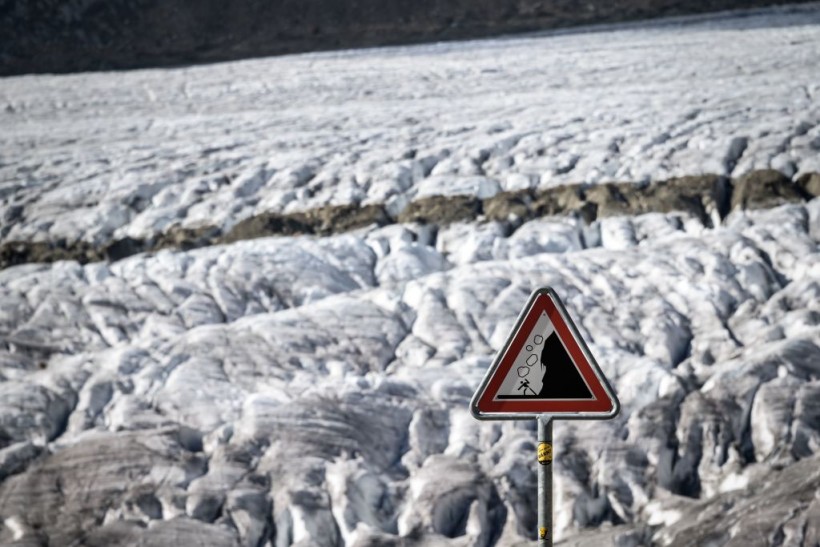A new geological study utilized a detailed satellite image to map out the landslide impacts in the great Amalia Glacier last 2019. According to the investigation, the event assisted the region's glaciers stabilize and pushed them to expand by approximately 1,000 meters three years after it occurred.
The Patagonian glacier study, led by scholars from the University of Minnesota Twin Cities, discovered for the first time that the massive landslide event last 2019 resulted in a significant impact on the region's glacier movements.
The research was made possible through the help of the data captured through satellite imaging during the year when one of Chile's great glaciers, known as the Amalia Glacier, dissolved and caused a landslide.
Amalia Glacier's 2019 Landslide Event

This picture was taken on October 01, 2019, and shows a warning sign for rockslide next to the Aletsch glacier above Bettmeralp, Swiss Alps. - The mighty Aletsch -- the largest glacier in the Alps -- could completely disappear by the end of this century if nothing is done to rein in climate change, a study shown on September 12, 2019, by ETH technical university in Zurich.
According to the findings, this landslide was the main factor that made the glacier cover bigger. Moreover, the melting process of the glacier gradually decreased over the following years after the fall.
The data collected from the changes in the Amalia Glacier could help experts carry out further studies about other glacial activities in the future and have a wider perspective of the possible risks of living near the vicinity of geological structures that are prone to landslides.
The glacier specialists have been tracking the geological movements of the glacial recession for more than decades now. Most research anchored to these monitoring procedures is based on the effects of uncontrolled warming throughout our planet.
The findings revealed that the Amalia Glacier was able to recede constantly for the past 100 years, ScienceDaily reports. Measurements show that the 150-kilometer glacier became smaller due to the loss of ice, and up to this date, it has already decreased to a total of 10 kilometers. These landslide effects, however, gained lesser attention from the studies.
Glacial Landslide Affects Ice Mass Expansion
Experts from the University of Minnesota saw that, after the great landslide of the Amalia Glacier back in 2019, the area it covers somehow grew quickly due to an abnormal advancement. Three years before, the glacier expanded and gained an estimated size of about a thousand meters.
Minnesota's N.H. Winchell School of Earth and Environmental Sciences specialist Max Van Wyk, who also led the study, explained that landslide activities are fairly natural on the frozen landforms. If the slides could stabilize the body of ice as shown in the data, then it could also influence the scale of the glaciers and how large they would be in the coming years, the expert continued.
Global warming and climate change are also considered in these investigations. Their impacts melt glaciers located around the world at large rates, and these commonly result in the rise of sea levels, Van Wyk added.
The landslide at the Amalia Glacier allowed the frozen chunk to increase in size by pushing its area downstream. The event also put the rocks and sediments to build on the border between the glacier and the ocean, serving as an adhesive to prevent the large icebergs from drifting off the coast and ultimately stabilizing the glacial structure.
Through the findings from the glacial landslides and their association with the communities near the proximity, the authors are now moving forward to supporting research that involves monitoring satellite imagery from the last 20 to 30 years to gather contributing information about the unrecorded glacial landslides in other regions.
The study was published in the journal Geology, titled "Atypical landslide induces speedup, advance, and long-term slowdown of a tidewater glacier."
RELATED ARTICLE: Sleeping Volcano Near Antarctic Causes Record-Breaking Earthquake on Southern Ice Sheet
Check out more news and information on Geology in Science Times.














